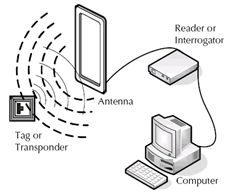| |

The first commercial use of Radio Frequency Identification (RFID) technology was in the area of Electronic Article Surveillance (EAS) systems. Since then, a large number of proprietary RFID systems have been introduced. These include, for example, applications that have become ubiquitous in today’s life, such as toll collection, building access control, or asset tracking systems for the tracking of products along the supply chain. The figure below provides an overview of the three basic elements that all these applications share: a computer or network system, an RFID reader with an attached antenna, and an RFID tag (i.e., transponder):

Model and Components of an RFID System
Source: http://ukrfid.innoware.co.uk/what_is_rfid/the_technology
RFID tags consist of a silicon chip with either just stores a unique identifier or more using a writable memory. By attaching RFID tags to items, RFID applications can individually identify these tagged physical objects. Tags are either passive, i.e., they are activated as soon as they receive an according signal and energy from an RFID reader, or they are active, i.e., the continuously emit a signal. Hence, no direct line of sight is necessary while data is exchanged wirelessly through radio frequency. RFID transponders exist in a multitude of designs, with plastic or glass housings, as contactless chip cards, or as paper thin “Smart Labels”. There are, depending on their transmission frequency, inter alia high-frequency (HF – 13.56 MHz) and ultra-high frequency tags (UHF – 915MHz in the USA or 868MHz in Europe).The above mentioned technical characteristics allow for the following key benefits of RFID as compared to the barcode:
- Reading without a direct line of sight: reading via radio frequency, from a distance and contactless through a number of materials such as cartoon, wood, etc.
- Bulk reading: reading many items at a time.
- Reading automation: RFID-tagged items within the reader’s read range can be automatically scanned and written. Hence the movements of these items can be continuously scanned by installed readers.
- Serialized identification: objects can be identified individually through the unique serial number on the RFID-transponders.
- Localization: since the position of fixed readers is known, it is possible – by means of triangulation – to identify the position of an RFID-tagged object.
However, it wasn’t until the development of international standards, the miniaturization, and the price decline, that RFID technology became economically feasible for deployment beyond niche applications. RFtrend’s goal is to exploit these advantages for its customers by providing them with cutting-edge soft- and hardware systems. |





